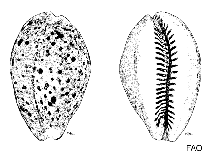Monetaria caputdraconis (Melvill, 1888)
| Native range | All suitable habitat | Point map | Year 2050 |

|
| This map was computer-generated and has not yet been reviewed. |
| Monetaria caputdraconis AquaMaps Data sources: GBIF OBIS |
Google image | No image available for this species;
drawing shows typical species in Cypraeidae.
Classification / Names Common names | Synonyms | CoL | ITIS | WoRMS
Gastropoda | Littorinimorpha | Cypraeidae
Environment: milieu / climate zone / depth range / distribution range Ecology
Demersal; depth range 0 - 30 m (Ref. 94005). Subtropical
Distribution Countries | FAO areas | Ecosystems | Occurrences | Introductions
Southeast Pacific: Easter Island and Sala y Gómez. Endemic to Easter Island.
Length at first maturity / Size / Weight / Age
Maturity: Lm 2.9, range 2 - 4.01 cm Max length : 3.5 cm ShL male/unsexed; (Ref. 8763)
Life cycle and mating behavior Maturity | Reproduction | Spawning | Eggs | Fecundity | Larvae
Main reference
References | Coordinator | Collaborators
Heiman, E. 2007 List of living cowry taxa Version 01. Personnal communication (12/08). (Ref. 8761)
IUCN Red List Status
(Ref. 130435: Version 2025-1)
CITES status (Ref. 108899)
CMS (Ref. 116361)
Threat to humans
Human uses
Fisheries: commercial
| FishSource |
Tools
More information
Diet composition
Food consumption
Predators
Max. ages / sizes
Length-weight rel.
Length-length rel.
Length-frequencies
Mass conversion
Abundance
Internet sources
BHL | BOLD Systems | CISTI | DiscoverLife | FAO(Publication : search) | Fishipedia | GenBank (genome, nucleotide) | GloBI | Gomexsi | Google Books | Google Scholar | Google | PubMed | Tree of Life | Wikipedia (Go, Search) | Zoological Record



